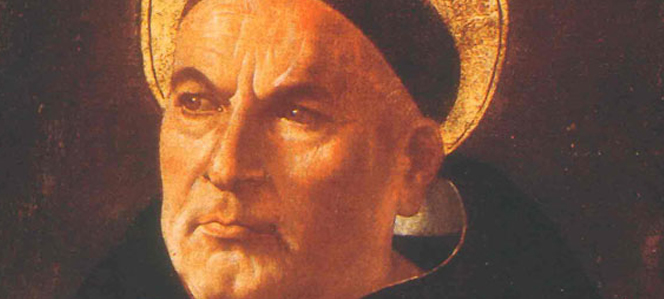I was in Rome the past couple of weeks, giving lectures at the North American College, the great seminary for Americans, Canadians, and Australians at the Vatican. One morning, toward the end of my stay, I met with my good friend, Fr. Paul Murray, the Irish Dominican spiritual writer, and we headed to the Vatican Library, where we met a colleague of Fr. Paul’s who works there in the manuscript section.
Fr. Murray had secured permission to view some “autographs” of St. Thomas Aquinas, that is to say, some writings in Thomas’s own hand. I was approaching this appointment with enormous enthusiasm, for Thomas, the church’s greatest theologian, is my hero, my patron saint, the person who, more than any other, had directed me toward the priesthood, and the scholar whose work I have been studying and writing about most of my adult life. I was not disappointed.
Fr. Paul’s friend invited us to sit down at a long table and told us that she would return in a few minutes with the sample of Aquinas’s writing. I was expecting, frankly, one page that we would be permitted to view, perhaps, under glass. But she returned with a dossier filled with eighty pages of text! They were vellum, which is to say, treated sheepskin, expensive enough and rather hard to come by in the Middle Ages; and they were covered in Aquinas’s famously cramped, illegible script.
We were able to see these pages directly, to handle them, to hover over them, just as Aquinas must have, nearly eight centuries ago. The texts we were looking at were from theSumma contra gentiles, the first and lesser of Thomas’s two great Summae or summaries of Christian doctrine, which he wrote in Paris in the late 1250’s, when he was a relatively young man (35 or so). Though both Fr. Paul and I had been studying Thomas’s Latin texts for years, neither one of us could make out one word. This is because Thomas wrote in a kind of shorthand, filled with symbols, squiggles, odd connectives. They say that only his secretary, a man named Reginald of Piperno, could read Thomas’s writing fluently. And indeed, in the margins of certain of these pages, another hand, far more legible, could be seen; it was undoubtedly that of the faithful Reginald.
The curator pointed out a wonderful detail. She showed us a particular page with a rather large hole in the middle. “You can tell,” she said, “that that defect was already there in the Middle Ages.” We wondered how she knew that, and she said, “Look at the writing.” And sure enough, there was the illegible hand writing suddenly taking a detour up and around the hole. On another page, we saw a fine little sketch of the head of a horse. Did Thomas draw it? Was it from a later time and another hand? There is no way to tell, but it certainly proves that he doodler’s art is a venerable one.
My favorite page was one that was covered with Thomas’s writing, practically top to bottom and side to side, all the margins filled in with new arguments or modifications or glosses. And at the foot of this page were the numbers 1,2,3, and 4, each with an uneven line stretching from it to a particular piece of text – probably four objections to which Thomas was responding. What these medieval writings communicated to me was the dense reality of Thomas Aquinas, that very particular 13th century scholar, scribbling on these sheets of vellum, as he thought and wrote his way to greater clarity about the things of God. The sheer concentration and effort that this required were inscribed in the still very black ink of those pages.
I have seen many beautiful things in Rome – the Pantheon, St. Peter’s Dome, Santa Maria in Trastevere, the Caravaggios in San Luigi dei Francesi, Raphael’s “School of Athens” – but I can honestly say that those pages of Aquinas were the most striking, memorable, and yes, beautiful things I have ever seen in the Eternal City. They reminded me of how much Thomas Aquinas has meant to me personally, but also how much he continues to mean for the entire church.
At a time when religious conversation far too often devolves into shouting matches and ad hominem attacks, Thomas calls us back to reasoned discourse. At a time when religious passions have run amok and have resulted in terrible acts of violence, Thomas calls us back to hard thinking about God. At a time when adepts of different religions often gaze at one another suspiciously, the Thomas who happily dialogued with pagan philosophers, Jewish rabbis, Muslim sages, and Christian heretics, calls us back to an attitude of broad-minded respect. I think actually that the Church’s turning away from Aquinas in the years following Vatican II was a dreadful mistake. We lost something of massive importance when we set aside his balance, his deep intelligence, and his sanity. Happily, there is a rather impressive Thomas Aquinas revival going on throughout the church, as a number of gifted younger scholars (and some older ones too) are turning back with enthusiasm to his works. May their tribe increase.
